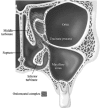A review of nasal polyposis
- PMID: 18728843
- PMCID: PMC2504067
- DOI: 10.2147/tcrm.s2379
A review of nasal polyposis
Abstract
Nasal polyps are common, affecting up to four percent of the population. Their etiology remains unclear, but they are known to have associations with allergy, asthma, infection, cystic fibrosis, and aspirin sensitivity. They present with nasal obstruction, anosmia, rhinorrhoea, post nasal drip, and less commonly facial pain. Clinical examination reveals single or multiple grey polypoid masses in the nasal cavity. Computerized tomography allows evaluation of the extent of the disease and is essential if surgical treatment is to be considered. Management of polyposis involves a combination of medical therapy and surgery. There is good evidence for the use of corticosteroids (systemic and topical) both as primary treatment and as postoperative prophylaxis against recurrence. Surgical treatment has been refined significantly over the past twenty years with the advent of endoscopic sinus surgery and, in general, is reserved for cases refractory to medical treatment. Recurrence of the polyposis is common with severe disease recurring in up to ten percent of patients.
Keywords: disease management; nasal polyps; surgical procedures.
Figures
References
-
- Albertien AC, Aukema MD, Mulder PDH. Treatment of nasal polyposis and chronic sinusitis with fluticasone propionate nasal drops reduces the need for sinus surgery. J Allergy Clin Immunol. 2005;115:1017–23. - PubMed
-
- Bachert C, Gevaert P, Holappels G, et al. Total and specific IgE in nasal polyps is related to local eosinophilic inflammation. J Allergy Clin Immunol. 2001;107:607–14. - PubMed
-
- Bachert C, Hormann K, Mosges R. An update on the diagnosis and treatment of sinusitis and nasal polyposis. Allergy. 2003;58:176–91. - PubMed
-
- Bachert C, Wagenmann M, Hauser U, et al. IL-5 synthesis is upregulated in human nasal polyp tissue. J Allergy Clin Immunol. 1997;99:837–42. - PubMed
-
- Badia L, Lund V. Topical corticosteroids in nasal polyposis. Drugs. 2001;61:573–8. - PubMed
LinkOut - more resources
Full Text Sources
Other Literature Sources
Miscellaneous





